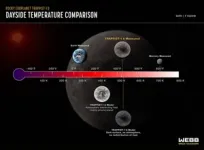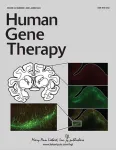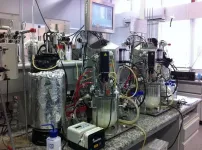(Press-News.org) When studying the brain, researchers are just beginning to use a method known as voltage imaging to track neural activity in the living animal. While this approach is a promising way to better understand neuron firing, behavior, and cognition, there are limitations and risk factors. The practice requires putting a lot of light into the brain (which can lead to overheating) and only has the capacity to image ten neurons at a time.
New research from Jerry Chen, a Boston University College of Arts & Sciences assistant professor of biology, and collaborators aims to address these challenges. Published today in Nature Methods, Chen and co-authors outline how their multidisciplinary approach using a new microscope, artificial intelligence algorithm, and voltage indicators can enhance the imaging process. Taken together, their methods resulted in successful, minimally invasive, and sustained imaging of approximately 100 neurons at a time in mice.
In this Q&A, Chen describes the new research findings, working with his collaborators, and the exciting implications for patients with epilepsy and future brain imaging technologies.
In your own words, please describe this study. What are your main research objectives?
Neuroscience, as a field, is interested in understanding how the brain works. Electrical signals are the primary way in which neurons compute information and communicate with each other. We can use electrodes to record the activity from individual neurons, but this is an invasive procedure that requires inserting electrodes into the brain. Imaging voltage signals provides a way to non-invasively read out activity across populations of neurons. There has been a lot of effort in the past decade to advance this voltage imaging technology. Our research objective was to help make it practical and scalable for research applications.
Is there a specific challenge this research aims to address?
Voltage imaging in the living animal means having to operate at the fundamental limits of both physics and biology. We need to express genetically encoded indicators that will change fluorescence in response to neuronal activity and we need microscopes that will allow us to image at very high speeds (at least 1000 frames per second) to measure action potentials (the main unit of information in neurons). Using our microscopes, we need to put just enough light into the brain to get fluorescence signals out. If we want to image from more and more neurons, we want to put more light into the brain. However, we can’t put too much into the brain otherwise we will cause photodamage. So the challenge is walking a tightrope between maximizing the signal and number of neurons we want to record at high-speed and minimizing the chance of causing damage to the brain.
You’ve described this work as a “multi-disciplinary approach,” as you collaborated with co-authors trained in cellular and molecular physiology, biomedical engineering, neurophotonics, and more. Can you elaborate on how these unique disciplines came together to support/influence different areas of the study?
In order to overcome the challenges I described above, there is no one solution that can do this. Instead, you need multiple approaches that will work in combination to overcome these fundamental limits. Specifically, we needed protein engineers that could develop more sensitive voltage indicators that will fluoresce in response to neuronal activity. As an optical engineer, I developed a new microscope that allows us to increase the number of neurons that we can image at very high speeds. Finally, we needed a computer scientist who could develop new algorithms using artificial intelligence that can extract the voltage signals under noisy conditions in which we are putting very little light into the brain.
Who are the key research collaborators?
Vincent Pieribone at Yale University’s John B. Pierce Laboratory developed the new voltage sensors. Lei Tian, an assistant professor within BU’s department of electrical and computer engineering developed the new denoising algorithms. Anderson Chen, senior imaging scientist with BU’s Neurophotonics Center and manager of the micro and nano imaging core facility, provided guidance in building our SMURF microscope. Ian Davison, associate professor in BU’s biology department, helped with testing the voltage sensors in our lab.
Through this study, did you uncover any results that surprised you?
I believe the denoising algorithm (called DeepVID) that Lei Tian developed is a game changer. When you’re imaging under low light conditions, the images that you collect can be very noisy. This is called shot noise. This is a fundamental limit in microscopy that prevents us from making reliable measurements using our instruments. The computational methods Lei developed breaks this fundamental limit. I was amazed when I saw how much more easily we could see the voltage signals after applying Lei’s denoising algorithm.
What are some of the long-term implications of the research findings? How can the results be applied to real-world patients or impact the future of brain imaging technologies?
The long-term implication is that we have developed a combined approach that will allow us to scale up voltage imaging. Before, we could only perform imaging with 10 neurons at a time. Our paper demonstrated that 100 neurons is possible. By extending on the principles that we have proved possible in practice, we should be able to image 1000 or more neurons. This will allow us to better understand how information is processed in the brain. It will also allow us to better study diseases in which electrical activity is disturbed like during epilepsy.
What are the next-steps for you and your collaborators?
Our next steps are to both apply our technologies to answer fundamental questions in neuroscience and also explore avenues for further scaling up this imaging towards larger neuronal populations.
This research was funded largely by the Brain Research Through Advancing Innovative Neurotechnologies (BRAIN) Initiative.
END
Breakthrough Brain Imaging: Experts use new microscope, AI algorithm, and voltage indicators to image electrical activity deep in the brain
BU neuroscientist and collaborators have developed a multidisciplinary approach using a new microscope, artificial intelligence algorithm, and voltage indicators to better measure brain activity.
2023-03-27
ELSE PRESS RELEASES FROM THIS DATE:
RIT researcher receives funding to improve infrastructure safety for nuclear waste disposal
2023-03-27
Researchers at Rochester Institute of Technology are investigating the combined physical effects of heat, chemical reactions, and seismic activity on concrete lining structures used to dispose of nuclear waste. Results from the work could improve nuclear waste infrastructure designs, better long-term safety management, and refine strategies to meet climate change targets.
Lu Sun, a professor in RIT’s College of Engineering Technology (CET), received a grant of nearly $500,000 from the Nuclear Regulatory Commission for “High temperature and seismic response of concrete lining structures and clay in nuclear waste disposal.” ...
NASA’s Webb measures the temperature of a rocky exoplanet
2023-03-27
An international team of researchers has used NASA’s James Webb Space Telescope to measure the temperature of the rocky exoplanet TRAPPIST-1 b. The measurement is based on the planet’s thermal emission: heat energy given off in the form of infrared light detected by Webb’s Mid-Infrared Instrument (MIRI). The result indicates that the planet’s dayside has a temperature of about 500 kelvins (roughly 450 degrees Fahrenheit) and suggests that it has no significant atmosphere.
This is the first detection of any form of light emitted by an exoplanet as small and as cool as the rocky planets in our own solar system. The result ...
Benefiting from orphan drug and rare pediatric disease designations for gene therapy
2023-03-27
Providing an overview of the submissions process and examples of U.S. Food and Drug Administration (FDA) applications for Orphan Drug Designation (ODD) and Rare Pediatric Disease Designation (RPDD), a new article can help developers of gene therapies for rare genetic diseases. The article is published in the peer-reviewed journal Human Gene Therapy. Click here to read the article now.
Anne Pariser and Elizabeth Ottinger, from the National Center for Advances in Translational Sciences (NCATS), National Institutes of Health, and coauthors, describe the ODD and RPDD programs, which provide financial incentives for the development of ...
Study paves way to more efficient production of 2G ethanol using specially modified yeast strain
2023-03-27
A Brazilian study paves the way to increased efficiency of second-generation (2G) ethanol production based on the discovery of novel targets for metabolic engineering in a more robust strain of industrial yeast. An article on the study is published in the journal Scientific Reports.
The databases compiled by the authors are at the disposal of the scientific community in the repository of the State University of Campinas (UNICAMP), which is a member of the Dataverse Project, an international collaborative initiative supported by FAPESP.
First-generation (1G) ethanol is produced from sources rich in carbohydrates ...
UC Davis Health collaborates with Propeller Health to improve clinical outcomes of COPD patients
2023-03-27
UC Davis Health and Propeller Health have announced a new collaboration that will offer personalized treatment for high-risk patients with asthma and chronic obstructive pulmonary disease (COPD) aiming to improve their health outcomes.
As part of the collaboration, UC Davis Health will provide the Propeller program – including sensors, mobile app, web portal, and personalized support – to eligible patients, with eventual expansion to patients in other UC locations and UC affiliates. The sensors attach to a patient’s inhaler to capture unique signals that record events, such as ...
Largest study to date of minipuberty identifies two new patterns of the reproductive hormone, AMH, in infant girls
2023-03-27
Minipuberty is a stage of reproductive development during infancy in both sexes when reproductive hormones change and reproductive organs develop. The importance of minipuberty is not well understood but could represent an opportunity for the early identification of future reproductive conditions and enable prompt treatment. Anti-Müllerian hormone (AMH) is one of the hormones that changes during minipuberty, and it plays a key role in the development of reproductive organs in boys. However, the role of AMH in infant girls is less clear.
In ...
Bomb-sniffing rodents undergo ‘unusual’ reproductive transformations
2023-03-27
ITHACA, N.Y. – Female giant African pouched rats, used for sniffing out landmines and detecting tuberculosis, can undergo astounding reproductive organ transformations, according to a new study.
The paper, “Extreme plasticity of reproductive state in a female rodent,” which published March 27 in Current Biology, explores how traits once considered “fixed” in adult animals may become variable under specific pressures.
Though these rodents could have important military, biodetection and humanitarian uses, breeding them at high rates has been a challenge. ...
ENGOT-EN6-NSGO/GOG-3031/RUBY trial results: The new standard of care in advanced/recurrent endometrial cancer
2023-03-27
EMBARGO DATE: Monday, March 27, 2023, 12:30 pm ET
PRESS RELEASE
ENGOT-EN6-NSGO/GOG-3031/RUBY trial results:
The new standard of care in advanced/recurrent endometrial cancer
ENGOT, NSGO-CTU & GOG-Foundation proudly announce the ground-breaking results of ENGOT-EN6-NSGO/GOG-3031/RUBY trial.
The results reveal improvement in overall survival at 24 months in whole study population from 56% (CP+placebo) to 71.3% (CP+dostarlimab). “although these are interim data, we believe they are robust and will be confirmed with longer follow-up.”, said Mansoor R Mirza.
The trial is presented on 27th of March 2023 through ESMO’s ...
Human body a breeding ground for antimicrobial resistance genes
2023-03-27
The community of microbes living in and on our bodies may be acting as a reservoir for antibiotic resistance, according to new research from the Earlham Institute and Quadram Institute in Norwich.
The use of antibiotics leads to ‘collateral damage’ to the microbiome, ramping0 up the number of resistance genes being passed back and forth between strains in the microbiome.
The findings also suggest these genes spread so easily through a population that, regardless of your own health and habits, the number of resistance genes in your gut is heavily influenced by national trends in antibiotic consumption.
The rise of antimicrobial resistance (AMR) among human pathogens is widely seen ...
U of I study gives a thumbs up to carefully formulated vegan diets for dogs
2023-03-27
URBANA, Ill. – In today’s pet food market, there are products to match nearly every lifestyle, value system, and price point pet owners demand, including vegan formulations. New University of Illinois research shows at least two human-grade, lightly cooked vegan diets provide adequate nutrition for dogs.
“The trends of vegan foods and human grade foods are increasing for dogs. Because people are feeding these diets to their pets, it’s important they be tested like all other foods to make sure they're safe and ‘complete and balanced,’” ...
LAST 30 PRESS RELEASES:
Making lighter work of calculating fluid and heat flow
Normalizing blood sugar can halve heart attack risk
Lowering blood sugar cuts heart attack risk in people with prediabetes
Study links genetic variants to risk of blinding eye disease in premature infants
Non-opioid ‘pain sponge’ therapy halts cartilage degeneration and relieves chronic pain
AI can pick up cultural values by mimicking how kids learn
China’s ecological redlines offer fast track to 30 x 30 global conservation goal
Invisible indoor threats: emerging household contaminants and their growing risks to human health
Adding antibody treatment to chemo boosts outcomes for children with rare cancer
Germline pathogenic variants among women without a history of breast cancer
Tanning beds triple melanoma risk, potentially causing broad DNA damage
Unique bond identified as key to viral infection speed
Indoor tanning makes youthful skin much older on a genetic level
Mouse model sheds new light on the causes and potential solutions to human GI problems linked to muscular dystrophy
The Journal of Nuclear Medicine ahead-of-print tip sheet: December 12, 2025
Smarter tools for peering into the microscopic world
Applications open for funding to conduct research in the Kinsey Institute archives
Global measure underestimates the severity of food insecurity
Child survivors of critical illness are missing out on timely follow up care
Risk-based vs annual breast cancer screening / the WISDOM randomized clinical trial
University of Toronto launches Electric Vehicle Innovation Ontario to accelerate advanced EV technologies and build Canada’s innovation advantage
Early relapse predicts poor outcomes in aggressive blood cancer
American College of Lifestyle Medicine applauds two CMS models aligned with lifestyle medicine practice and reimbursement
Clinical trial finds cannabis use not a barrier to quitting nicotine vaping
Supplemental nutrition assistance program policies and food insecurity
Switching immune cells to “night mode” could limit damage after a heart attack, study suggests
URI-based Global RIghts Project report spotlights continued troubling trends in worldwide inhumane treatment
Neutrophils are less aggressive at night, explaining why nighttime heart attacks cause less damage than daytime events
Menopausal hormone therapy may not pose breast cancer risk for women with BRCA mutations
Mobile health tool may improve quality of life for adolescent and young adult breast cancer survivors
[Press-News.org] Breakthrough Brain Imaging: Experts use new microscope, AI algorithm, and voltage indicators to image electrical activity deep in the brainBU neuroscientist and collaborators have developed a multidisciplinary approach using a new microscope, artificial intelligence algorithm, and voltage indicators to better measure brain activity.






